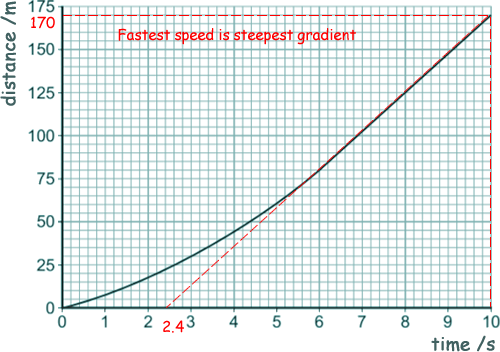GCSE Questions: Momentum
Q3. (a) A car driver sees the traffic in front is not moving and brakes to stop his car.

The stopping distance of a car is the thinking distance plus the braking distance.
(i) What is meant by the 'braking distance'?
Braking distance is the distance travelled under the braking force - the distance travelled between applying the brakes and stopping. 
[1 mark]
(ii) The braking distance of a car depends on the speed of the car and the braking force. State one other factor that affects braking distance.
Any one from: 
weather conditions - such as icy/wet roads
condition of the tyres
type of road surface
gradient of the road
mass (of car and passengers)
(efficiency/condition of the) brakes
[1 mark]
(iii) How does the braking force needed to stop a car in a particular distance depend on the speed of the car?
The greater the speed, the greater the braking force required to stop a car within a particular distance. 
[1 mark]
(b) The graph below shows the distance–time graph for the car in the 10 seconds before the driver applied the brakes.

Use the graph to calculate the maximum speed the car was travelling at.
Show clearly how you work out your answer.
Maximum speed = gradient of the graph at the steepest point
= (170 - 0)/(10 - 2.5)
= 170/7.4
= 22.4  m/s
m/s 
[3 marks]
(c) The car did not stop in time. It collided with the stationary car in front, joining the two cars together.

The diagram shows both cars, just before and just after the collision.
(i) The momentum of the two cars was conserved. What is meant by the statement 'momentum is conserved'?
It means that the total momentum stays the same, that the total momentum before an event equals the total momentum after it happens. 
[1 mark]
(ii) Calculate the velocity of the two joined cars immediately after the collision.
Σ momentum before = Σ momentum after
Σ mv (before) = Σ mv (after)
1500 x 8 + 900 x 0 = (1500 + 900) v
12000  = 2400 v
= 2400 v 
v = 12000/2400 = 5 m/s 
[3 marks]
(d) Since 1965, all cars manufactured for use in the UK must have seat belts.
It is safer for a car driver to be wearing a seat belt, compared with not wearing a seat belt, if the car is involved in a collision.
Explain why.
The seat belt stretches  as the braking force is applied. This increases the time it takes for the driver to slow down and stop
as the braking force is applied. This increases the time it takes for the driver to slow down and stop  than s/he would when hitting a hard surface to stop - for example the windscreen or steering wheel.
than s/he would when hitting a hard surface to stop - for example the windscreen or steering wheel.
Ft = Δp

The change in momentum of the driver as s/he comes to a stop has two components - the force experienced and the time interval over which the change occurs. Increasing the time interval decreases the force experienced as that change in momentum occurs.
Increasing the time interval decreases the force experienced as that change in momentum occurs. 
[4 marks]
[14 Marks TOTAL]









